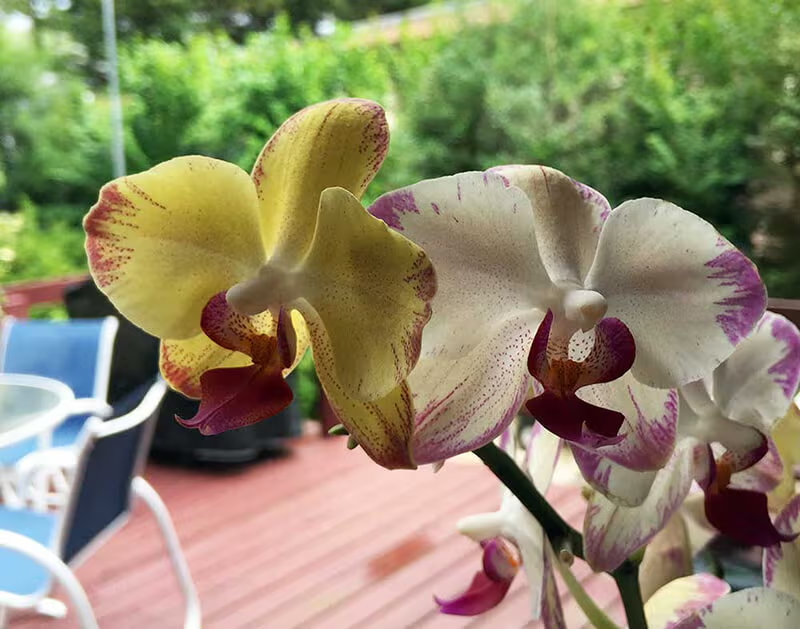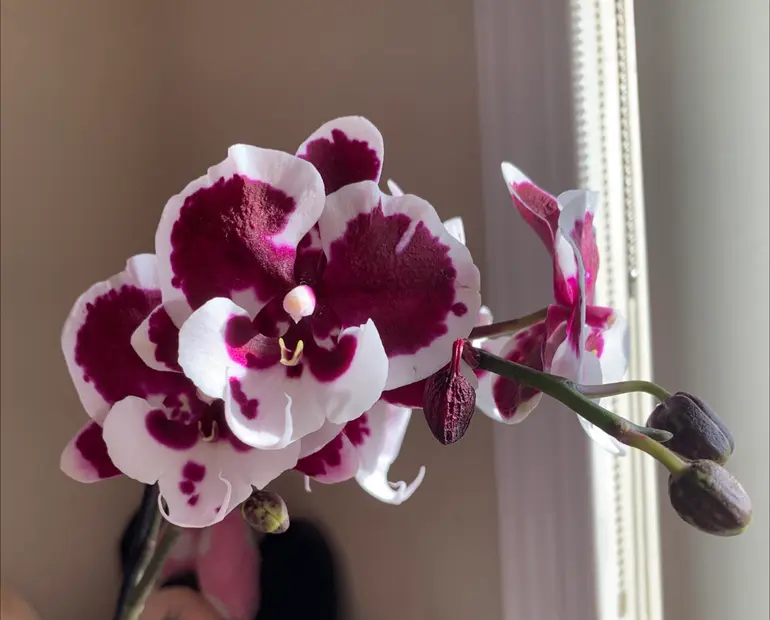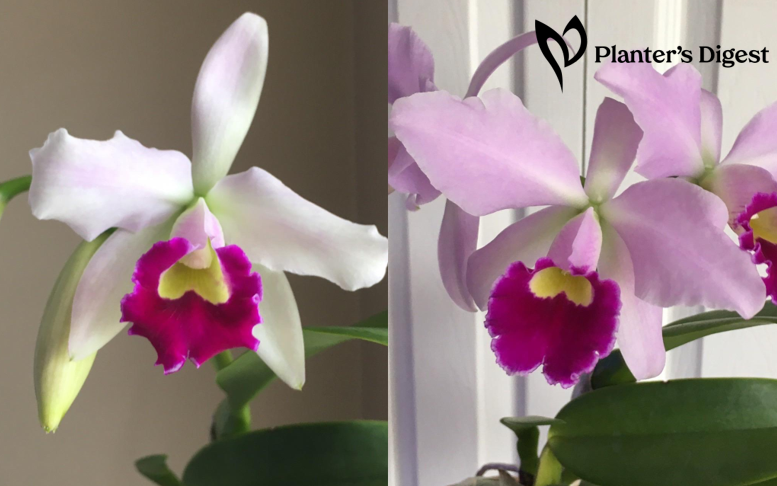I always thought orchids were these fancy, unchanging plants until one day, my favorite orchid pulled a surprise on me. It went from a stunning purple to a mysterious blue—it kept me guessing for sure!
Curious about this, I dug into some plant research and talked with a few botanists. I finally figured out why orchids do this magical transformation.
These flowers are real drama queens. Even a tiny change in their environment can give them a whole new look!
So, let’s relax with a cup of coffee and explore the world of these surprising, color-changing orchids. By the end, you’ll see your orchids in a whole new light!
Natural Reasons Why Orchids Change Color

Light Exposure
When orchids get more sunlight, especially indirect light, their colors can really pop. It’s because the light boosts pigment production in the petals, turning soft pinks into vibrant fuchsias and pale yellows into bright golds.
It’s a natural sun-kissed effect that makes your blocks look more vibrant. But it’s not just about more light; too little light can also cause a change. Orchids that don’t get enough sunlight often produce less pigment, making their colors look washed out or dull.
Care tips:
Adjusting how much light your plant gets can help keep its colors intense and lively.
Temperature Changes
Orchids can be pretty sensitive to temperature changes, which can cause their colors to shift. When orchids experience cooler temperatures, it can lead to the blooms becoming more vibrant.
This happens because cool air enhances pigment production, making those reds, blues, and purples appear richer and more intense. On the flip side, warm temperatures can sometimes cause your orchid’s color to become more muted.
Heat can slow down pigment production and even lead to a fading effect, where the colors look softer or paler. It’s almost as if the flowers are feeling a bit too relaxed in the warmth.
Care tips:
Keep an eye on the temperature of your orchid. By ensuring a balanced climate, you can help your orchid display its best, most vivid colors.
Age of Flowers
As orchids age, their flowers can gradually change color, adding to their unique charm. When orchids bloom, their colors are often at their most vibrant and intense.
Over time, you might see these bright hues start to mellow out. This natural aging process can transform a vivid flower into a softer, pastel version of itself. This is just part of the natural lifecycle of orchid flowers.
As they age, they produce less pigment, and the pigments already there can start to break down. This means the colors might fade or shift, giving the flower a more subtle look.
Care tips:
As your orchid matures, it’s important to balance its care. Keep it in soft, indirect sunlight to slow color fading and water lightly to maintain moist soil without overdoing it.
Nutrient Availability
Orchids can be a bit picky about their nutrients, and it shows in their flower color. When they get the right stuff, like nitrogen, phosphorus, and potassium, their blooms usually look more vibrant and healthy.
These nutrients help make those reds, yellows, and purples stand out. But if your orchid isn’t getting enough nutrients, you might see the colors starting to fade.
Without the proper “fuel,” the petals can look dull and washed out. It’s a clear sign that your orchid needs a bit more love in the feeding department.
Care tips:
Make sure you’re using a balanced fertilizer that’s made for orchids. With the right nutrients, those blooms will stay bright and beautiful.
Genetic Mutation
Orchids can surprise us with unexpected color changes due to genetic mutations. These mutations, often spontaneous, can alter the pigments responsible for an orchid’s color, leading to fascinating variations.
You might see an orchid suddenly develop streaks or patches of a new hue, thanks to these genetic quirks. These mutations occur when there’s a change in the orchid’s DNA affecting pigment production.
The result can be anything from a minor color variation to a completely new and unique shade. For orchid enthusiasts, these unexpected color shifts can be an exciting discovery, adding a layer of uniqueness to their collection.
Care tips:
Support your orchid through these changes by providing optimal care—moderate watering, indirect light, and the right temperature and humidity. Avoid drastic changes in its environment to prevent stress.
Stress
Orchids sometimes change color when they’re stressed out. Things like sudden temperature changes, irregular watering, or poor lighting can mess with the pigments in their flowers.
When under stress, orchids often make anthocyanins, which are pigments that can turn flowers a reddish or purplish color. It’s kind of like how leaves change color in the fall—it’s the plant’s way of saying something’s not quite right.
Care tips:
Review your care routine and adjust it accordingly. To prevent unwanted color changes, keep a close eye on environmental factors.
Ensure your orchids are not exposed to sudden temperature fluctuations, as this can be particularly stressful for them.
Mycorrhizal Fungi
Orchids have a unique relationship with mycorrhizal fungi. These fungi team up with the orchid’s roots to help the plant soak up nutrients better. In exchange, the fungi get some essential sugars from the orchid.
The fungi make sure the orchid can tap into a nutrient-rich environment, boosting its natural colors and giving the flowers that extra factor.
Care tips:
Focus on creating a healthy root environment. Use an orchid-specific potting mix that mimics their natural habitat, which is designed to facilitate this partnership by providing the right balance of aeration and moisture.
Artificial Reasons Why Orchids Change Color

Dye Injection
Some growers use dye injection to change the color of orchids. They inject dye into the stem or roots, and this color spreads to the flowers, creating some pretty vibrant, unusual shades.
This is how you end up with orchids in bright blues or deep purples that you wouldn’t normally see in nature.
Colored Water
Colored water is another way growers change the color of orchids. By adding dye to the water the orchids absorb, the flowers can be temporarily altered. This method is often used to produce unique and vibrant blooms that wouldn’t naturally occur.
While using colored water can lead to eye-catching results, it’s a temporary effect. As the orchid continues to grow and new flowers emerge, they will revert to the plant’s natural color.
Chemical Treatments
Some growers apply specific chemicals to the roots or leaves, which can alter the pigment in the flowers. This often results in bright and unusual colors that really stand out.
But the chemicals can stress the plant over time, possibly affecting its growth and health. Plus, the color change is usually just for one bloom cycle; the next set of flowers will likely go back to the orchid’s natural color.
Grafting
Grafting is a fascinating method where different orchid species are combined to create unique color blends. It’s done by attaching parts from two plants so they grow together as one.
The result is an orchid that shows off a beautiful mix of colors from both parent plants. Unlike using dyes or chemicals, grafting is a bit more permanent because it involves swapping plant tissues.
FAQs About Why Orchids Change Color
Are there specific orchid varieties known for color changes?
Yes, certain varieties, such as Phalaenopsis and Cymbidium, are more prone to color change due to environmental influences.
Are chemical treatments safe for orchids?
Chemical treatments can stress orchids, affecting their health over time, but they can create striking color changes temporarily.
Why did only part of my orchid flower change color?
Partial color change in a flower could be due to uneven light exposure, localized nutrient or water absorption, or even variegation in the plant’s genetics, causing a mosaic of colors on the petals.





